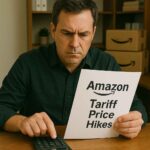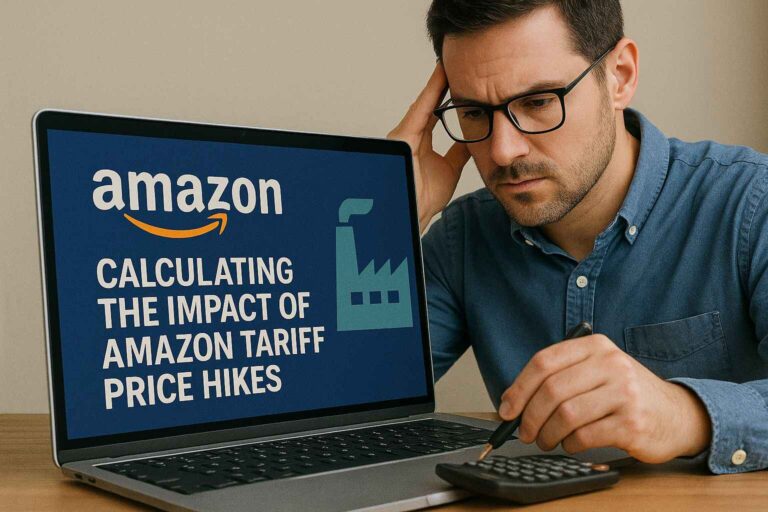Handling Amazon tariff price hikes without a strategy? That’s how you turn a price adjustment into a conversion nightmare.
Face it: new import tariffs are a gut punch, potentially adding 7.5% to 100% to your landed costs, especially from China. Your old math is useless, and margins are shrinking fast.
So you’re sweating: eat the costs and lose profit, or make impulsive price hikes and risk killing sales velocity or losing the Buy Box? Slashing ads in panic mode is another dead end. These tariffs could expose weak business strategies.
Enough guessing. Get a smart playbook for handling amazon tariff price hikes. It’s about assessing the real hit and raising prices intelligently to protect your business amidst the tension from tariff implementation by President Donald Trump.
Build this strategy yourself, or partner with an expert Amazon agency. Either way, you need a plan, not panic. Let’s dive in.
Table of Contents
1. Handling Amazon tariff price hikes: understand what to pay
Before you start raising Amazon prices, get clear on what’s actually hitting your wallet. Tariffs aren’t just a flat number—they stack up fast and change often. If you’re sourcing from China, Mexico, or Canada, here’s what you’re likely dealing with:
Baseline Tariff: ~10% on most imports.
China Reciprocal Tariffs: Add 34%—sometimes pushing total effective rates over 100%, even 125%, depending on product category.
IEEPA Tariffs: Another 10–20% tacked on to some Chinese goods.
Expired Exemptions: Many former tariff exclusions have ended, removing past relief.
Now add this: the De Minimis rule is gone for Chinese shipments as of May 2, 2025. That means no more duty-free entry for shipments under $800. You’re now looking at duties as high as 90–120% or flat fees of $75–$150, even for small postal shipments.
All this feeds into your Total Landed Cost, which includes:
Product cost
Shipping
Duties & tariffs
Customs fees
Insurance
Packaging
Warehousing
Taxes
If you’re still pricing your products with a simple cost-plus model, you’re flying blind. These new tariff layers don’t just raise costs, they blow up your margins if you’re not calculating them properly.
Especially for smaller third-party sellers, this can become a make-or-break issue fast. Understanding your true landed cost is the first step to handling Amazon tariff price hikes without making reckless pricing decisions.

Tackle Tariffs Head-On
Prepare, Price, Protect: Learn how to adjust pricing and build a strategy to offset rising tariffs without losing sales.
2. Amazon sellers, calculate how much to pay
Guesswork has no place here. If you don’t calculate how tariffs affect your margins, you could be making decisions that bleed your business dry.
Here’s how to calculate the tariff’s impact on business profitability, according to LedgerGurus:
Let’s say your Cost of Goods Sold (COGS – the direct costs tied to making your product) is normally 20% of your selling price. If a 10% tariff hits those goods, it doesn’t just add 10% to your price. It adds 10% to your cost.
So, 10% of that 20% COGS is an extra 2% cost relative to your sales price. If you do nothing, your net profit margin just dropped by 2 percentage points (e.g., from 10% down to 8%).
And if you’re facing a 25% tariff (like those discussed for Canada/Mexico), that 60% COGS business takes a brutal 15% hit to its net profit margin (25% of 60%).
Now that’s just the start. Tariffs are calculated based on Customs Value, which includes product cost, international freight, and insurance, often the largest chunk of your COGS. For Chinese goods, hikes from 7.5% to over 100% are not uncommon.
We’ve seen sellers watch margins crash from 31% to 12% overnight. Some products become dead weight unless you either raise prices or cut costs elsewhere.
Don’t fly blind:
Use real-time data and accurate cost-tracking tools.
Review tariff-inclusive landed costs regularly.
Avoid outdated spreadsheets and assumptions.
This math isn’t optional, it’s the foundation for handling Amazon tariff price hikes and making smart pricing decisions that protect your margins.

3. Amazon tariff price hikes: look beyond pricing to absorb costs from current and new tariffs
Before hiking your prices, explore other ways to cushion the blow of rising tariff because passing costs straight to customers should be a last resort.
Start with your supply chain:
Diversify sourcing – Shift away from high-tariff regions like China. Many sellers on Amazon are exploring Vietnam, India, and Mexico.
Negotiate smarter – Push for better terms, shared costs, or bulk shipping to lower freight expenses.
Tariff engineering – Modify product design or classification (legally) to qualify for lower duty rates.
- China is becoming a less reliable sourcing option due to rising tariffs on Chinese imports, closed import loopholes, and shifting U.S. trade policies.
- Sellers should start diversifying their supply chains by negotiating with current suppliers and exploring alternatives like Mexico, India, or the U.S.
Next, tighten your operations:
Reduce packaging size to qualify for lower FBA tiers.
Streamline workflows to boost efficiency.
Rethink ad spend and don’t cut blindly. Instead, focus on boosting conversion rates.
Drop unprofitable SKUs that can’t survive the new cost structure.
That said, when tariffs hit 100% or more, even the best optimizations may fall short. Supplier concessions are limited, and shifting production is expensive and slow. In many cases, raising prices becomes inevitable, just to stay afloat.
These strategies won’t eliminate the impact, but they can reduce how much you need to pass on to customers—and help you build a more resilient Amazon business.
4. Handling Amazon tariff price hikes: increase prices gradually
If a price increase is unavoidable, don’t spike it overnight. That’s a fast track to losing the Buy Box or triggering Amazon’s pricing alerts.
Instead, follow a slow, strategic approach:
Raise prices incrementally, around 10–15% at a time.
Allow time for sales to stabilize before the next increase, expecting a few weeks between steps.
Avoid sticker shock for customers and pricing errors flagged by Amazon’s algorithm.
To minimize disruption:
Some sellers raise MSRP first, then “Your Price” a week later.
Others adjust both together, but the key is consistency across all channels.
Update pricing on your own website, Walmart, eBay, and ensure resellers follow MAP policies. Amazon scrapes the web—lower prices elsewhere can cost you the Buy Box.
While this approach keeps you in Amazon’s good graces, it can delay the margin recovery you need, especially if tariffs force a 20–50% hike. During that time, cost-saving moves across your business become essential to protect your bottom line.
5. Handling price hikes from China tariffs: monitor your conversion rate
Raising your prices on Amazon can feel like walking a tightrope.
The fear? You’ll tank your conversion rate (the percentage of visitors who buy after landing on your listing). That fear isn’t unfounded: for lower-priced products, customers are often price-sensitive, and big jumps in pricing can hurt your performance.
But here’s the reality: conversion rate isn’t driven by price alone. Perceived value carries just as much (if not more) weight.
What You Need to Know
Higher prices = lower conversion is often true, but not always. If your product looks premium, a higher price can increase conversions.
Lower prices won’t fix a bad listing. You can’t discount your way out of poor images, weak copy, or unclear benefits.
Amazon rewards profit, not just volume. It’s about balancing price and sales velocity.
How to Protect (or Even Improve) Your Conversion Rate
Go Slow With Price Increases
Use gradual, small increments instead of sudden jumps. This helps avoid sticker shock and gives the market time to adjust.
Upgrade Your Listing to Match the Price
Your price should reflect what you’re offering. Boost your perceived value by improving:
Main images that grab attention.
Bullet points that speak to customer benefits.
A+ Content that builds trust and educates (Amazon reports this can raise conversion rates from ~5.6% to as much as 20% with premium content).
Track Metrics Closely
Monitor these KPIs in your Business Reports:
Unit Session Percentage (conversion rate)
Sessions (traffic)
Units Ordered
Buy Box Percentage
If conversions drop sharply after a price change, reassess your listing or value proposition.
Test With Temporary Promotions
Use coupons or limited-time discounts when rolling out a price hike. This maintains momentum while introducing the new price gradually.
Understand Your Product’s Price Sensitivity
Products priced over $100 are generally less impacted by small increases. With these, it’s better to double down on branding and visibility instead of constant price adjustments.
Handling Amazon tariff price hikes: FAQs
What's the safest way to raise prices on Amazon?
How do I prevent losing the Buy Box when increasing prices?
Amazon's Fair Pricing Policy is key. Avoid prices "significantly higher than recent prices offered on or off Amazon". Use the incremental increase strategy (Q4).
Ensure price consistency across all channels. Monitor your Buy Box percentage, conversion rate, and sales velocity closely.
Using FBA helps. If suppressed unfairly, open a case with Seller Support with proof.
How can I justify a higher price to customers?
Focus on value. Optimize your listing relentlessly: use high-quality images/video, write benefit-driven titles and bullet points, and tell a compelling story in your description.
Leverage A+ Content (Basic or Premium) to showcase features, build trust, and create a professional look. Build a strong brand identity that communicates quality and resonates with your target audience.
Will raising my price kill my conversion rate?
It can, especially for lower-priced items or with large, sudden increases. However, conversion rate isn't solely about price; perceived value matters immensely.
Sometimes, a higher price can even increase conversions if it signals higher quality. Mitigate the impact by raising prices incrementally, significantly boosting perceived value through listing optimization and A+ Content, and monitoring your metrics.
What metrics should I track closely when adjusting prices?
Monitor these key performance indicators (KPIs) in your Seller Central Business Reports:
- Unit Session Percentage (Conversion Rate): Tracks how effectively your listing turns visitors into buyers.
- Sessions (Page Visits): Shows if traffic is dropping off.
- Units Ordered / Total Sales ($): Tracks overall sales volume and revenue.
- Buy Box Percentage: Shows how often you're winning the Buy Box.
- Best Sellers Rank (BSR): Indicates your product's ranking within its category. Watch these trends closely before and after each price change.
Get Proactive, Not Punished by Tariffs
Rising tariffs aren’t just a temporary headache. They’re a long-term pressure test on your margins, pricing, and supply chain. Sellers who adapt quickly with a structured, data-driven approach will protect profitability and outlast those who rely on guesswork.
If you’re unsure how to recalibrate your pricing, sourcing, or conversion strategy in this environment, don’t go it alone. Our full service Amazon agency has helped hundreds of brands build resilient operations and navigate shifting global trade dynamics.
Need a game plan for tariffs?
Contact My Amazon Guy today for expert help in protecting your margins and growing your brand—no matter how high the tariffs climb.




